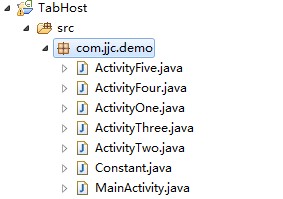底部菜单栏(二) TabHost & RadioGroup 实现
需求:使用TabHost & RadioGroup实现底部菜单栏;
效果图:

实现分析:
1.目录结构:


代码实现:
1. activity_main.xml
<?xml version="1.0" encoding="utf-8"?>
<TabHost xmlns:android="http://schemas.android.com/apk/res/android"
android:id="@android:id/tabhost"
android:layout_width="fill_parent"
android:layout_height="fill_parent" > <LinearLayout
android:layout_width="fill_parent"
android:layout_height="fill_parent"
android:orientation="vertical" > <FrameLayout
android:id="@android:id/tabcontent"
android:layout_width="fill_parent"
android:layout_height="0.0dip"
android:layout_weight="1.0" /> <TabWidget
android:id="@android:id/tabs"
android:layout_width="fill_parent"
android:layout_height="wrap_content"
android:layout_weight="0.0"
android:visibility="gone" /> <RadioGroup
android:id="@+id/main_radiogroup"
android:layout_width="fill_parent"
android:layout_height="wrap_content"
android:layout_gravity="bottom"
android:background="@drawable/tab_widget_background"
android:gravity="center_vertical"
android:orientation="horizontal"
android:padding="2dip" > <RadioButton
android:id="@+id/RadioButton0"
style="@style/tab_item_background"
android:checked="true"
android:drawableTop="@drawable/tab_icon1"
android:text="主页" /> <RadioButton
android:id="@+id/RadioButton1"
style="@style/tab_item_background"
android:drawableTop="@drawable/tab_icon2"
android:text="关于" /> <RadioButton
android:id="@+id/RadioButton2"
style="@style/tab_item_background"
android:drawableTop="@drawable/tab_icon3"
android:text="设置" /> <RadioButton
android:id="@+id/RadioButton3"
style="@style/tab_item_background"
android:drawableTop="@drawable/tab_icon4"
android:text="搜索" /> <RadioButton
android:id="@+id/RadioButton4"
style="@style/tab_item_background"
android:drawableTop="@drawable/tab_icon5"
android:text="更多" />
</RadioGroup>
</LinearLayout> </TabHost>
2. styles.xml
<style name="item_tab_text_style">
<item name="android:textSize">10.0dip</item>
<item name="android:textColor">#ffffffff</item>
<item name="android:ellipsize">marquee</item>
<item name="android:singleLine">true</item>
</style> <style name="tab_item_background">
<item name="android:textAppearance">@style/item_tab_text_style</item>
<item name="android:gravity">center_horizontal</item>
<item name="android:background">@drawable/tab_background_selector</item>
<item name="android:layout_width">fill_parent</item>
<item name="android:layout_height">wrap_content</item>
<item name="android:button">@null</item>
<item name="android:drawablePadding">3.0dip</item>
<item name="android:layout_weight">1.0</item>
</style>
3. MainActivity.java
package com.jjc.demo; import com.jjc.demo.Constant.ConValue; import android.app.TabActivity;
import android.content.Intent;
import android.os.Bundle;
import android.widget.RadioGroup;
import android.widget.RadioGroup.OnCheckedChangeListener;
import android.widget.TabHost;
import android.widget.TabHost.TabSpec; public class MainActivity extends TabActivity { //定义TabHost对象
private TabHost mTabHost; //定义RadioGroup对象
private RadioGroup radioGroup; @Override
protected void onCreate(Bundle savedInstanceState) {
super.onCreate(savedInstanceState);
setContentView(R.layout.activity_main); initView();
initData();
} /**
* 初始化组件
*/
private void initView() {
// 实例化TabHost对象,得到TabHost
mTabHost = getTabHost(); // 得到Activity的个数
int count = ConValue.mTabClassArray.length; for (int i = 0; i < count; i++) {
//为每一个Tab按钮设置图标、文字和内容
TabSpec tabSpec = mTabHost.newTabSpec(ConValue.mTextViewArray[i]).setIndicator(ConValue.mTextViewArray[i]).setContent(getTabItemIntent(i));
//将Tab按钮添加进Tab选项卡中
mTabHost.addTab(tabSpec);
} //实例化RadioGroup
radioGroup = (RadioGroup) findViewById(R.id.main_radiogroup);
} private void initData(){
// 给radioGroup设置监听事件
radioGroup.setOnCheckedChangeListener(new OnCheckedChangeListener(){ @Override
public void onCheckedChanged(RadioGroup group, int checkedId) {
switch (checkedId) {
case R.id.RadioButton0:
mTabHost.setCurrentTabByTag(ConValue.mTextViewArray[0]);
break;
case R.id.RadioButton1:
mTabHost.setCurrentTabByTag(ConValue.mTextViewArray[1]);
break;
case R.id.RadioButton2:
mTabHost.setCurrentTabByTag(ConValue.mTextViewArray[2]);
break;
case R.id.RadioButton3:
mTabHost.setCurrentTabByTag(ConValue.mTextViewArray[3]);
break;
case R.id.RadioButton4:
mTabHost.setCurrentTabByTag(ConValue.mTextViewArray[4]);
break;
default:
break;
} }});
} /**
* 给Tab选项卡设置内容(每个内容是一个Activity)
*/
private Intent getTabItemIntent(int index) {
Intent intent = new Intent(this, ConValue.mTabClassArray[index]);
return intent;
}
}
总结:android:textAppearance设置文字外观。如 “?android:attr/textAppearanceLargeInverse”这里引用的是系统自带的一个外观,?表示系统是否有这种外观,否则使用默认的外观。
代码:http://pan.baidu.com/s/1nh9X8
底部菜单栏(二) TabHost & RadioGroup 实现的更多相关文章
- 完美逆向百度手机助手5.0底部菜单栏 - Android Tabhost 点击动画
先看看百度手机助手5.0的样子: 发现他是用一个CustomTabHost.java来实现底部TabHost点击效果的,很漂亮,点击Tab的时候文字会上跑,图片会从底部跑出来的一个小动画. 下面我用自 ...
- 【Android UI设计与开发】5.底部菜单栏(二)使用Fragment实现底部菜单栏
既然 Fragment 取代了TabActivity,当然 TabActivity 的能实现的菜单栏,Fragment 当然也能实现.主要其实就是通过菜单栏的点击事件切换 Fragment 的显示和隐 ...
- 底部菜单栏(一) TabHost实现
需求:使用TabHost实现底部菜单栏: 效果图: 实现分析: 1.目录结构: 代码实现: 1.activity_main.xml <?xml version="1.0" e ...
- 【Android开发笔记】底部菜单栏 FragmentTabHost
公司项目,需求本来是按照谷歌官方指南写的,菜单栏设计成在导航栏下方 结果呢,审评时,BOSS为了和iOS统一,改成了底部菜单栏(标准结局),我只能呵呵呵呵呵呵呵 查了查资料发现实现底部菜单栏用的是Fr ...
- FragmentTabHost+FrameLayout实现底部菜单栏
现在一般的app都使用底部菜单栏,那具体怎么实现的呢!我们就来看看 首先给大家展示一下布局文件 1 <LinearLayout xmlns:android="http://schema ...
- 我的Android之路——底部菜单栏的实现
底部菜单栏的实现 底部菜单栏两种实现方法:ViewPager:可滑动的界面:Fragment:固定的界面. 首先,页面布局,在除去顶部toolbar之后,将主界面分为两部分,一部分为界面显示区,另一部 ...
- Android底部菜单栏+顶部菜单
底部菜单栏+顶部菜单(wechat)demo http://blog.csdn.net/evankaka/article/details/44121457 底部菜单demo http://blog.c ...
- 【转】【Android UI设计与开发】第07期:底部菜单栏(二)Fragment的详细介绍和使用方法
原始地址:http://blog.csdn.net/yangyu20121224/article/category/1431917/1 由于TabActivity在Android4.0以后已经被完全弃 ...
- 底部菜单栏(三)Fragment+FragmentTabHost实现仿新浪微博底部菜单栏
一.实现效果图 二.项目工程结构 三.详细代码编写 1.主tab布局界面,main_tab_layout: 双击代码全选 1 2 3 4 5 6 7 8 9 10 11 12 13 14 15 16 ...
随机推荐
- 无法将 lambda 表达式 转换为类型“System.Delegate”,因为它不是委托类型
this.BeginInvoke(() => { this.btnQuery.Enabled = false; //禁用查询 }); 跨线程调用时,编译上面的代码将提示 对于Control.In ...
- python正则表达式——re模块
http://blog.csdn.net/zm2714/article/details/8016323 re模块 开始使用re Python通过re模块提供对正则表达式的支持.使用re的一般步骤是先将 ...
- UNDERSTANDING CALLBACK FUNCTIONS IN JAVASCRIPT
转自: http://recurial.com/programming/understanding-callback-functions-in-javascript/ Callback functio ...
- 将集成spring的项目从tomcat上移植到weblogic下存在的问题
当在weblogic下部署时, 1.需要jersey-servlet-xx.jar,jersey-core-xx.jar,jersey-server-xx.jar: 2.在web.xml中全局参数co ...
- 欧拉工程第71题:Ordered fractions
题目链接:https://projecteuler.net/problem=71 If n<d and HCF(n,d)=1, it is called a reduced proper fra ...
- flexbox弹性盒子布局
混合划分 demo1,css: #demo1{ width: 100%; background: #ccc; display: -webkit-flex;/*表示使用弹性布局*/ } #demo1 . ...
- PHP获取服务器的mac地址类
PHP获取服务器的mac地址类,不是客户端的. <?php class GetMacAddr{ var $return_array = array(); // 返回带有MAC地址的字串数组 va ...
- python mysql 简单总结(MySQLdb模块 需另外下载)
python 通过DB-API规范了它所支持的不同的数据库,使得不同的数据库可以使用统一的接口来访问和操作. 满足DB-API规范的的模块必须提供以下属性: 属性名 描述 apilevel DB-AP ...
- Use Eclipse to develop groovy[docs.codehaus.org]
http://docs.codehaus.org/display/GROOVY/Install+Groovy-Eclipse+Plugin http://docs.codehaus.org/displ ...
- android bitmap out of memory总结、心得
setImageBitmap或setImageResource或BitmapFactory.decodeResource来设置一张大图,这些函数在完成decode后,最终都是通过java层的creat ...
